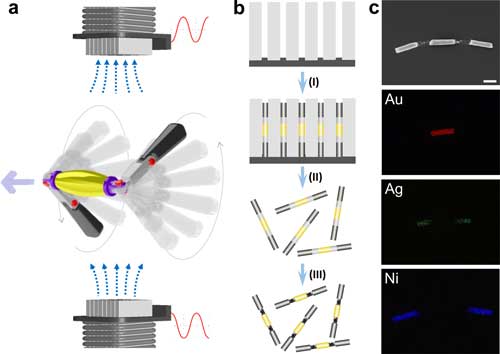| Posted: Jul 20, 2017 | |
Freestyle nanoswimmers offer new opportunities for biomedical nanobots(Nanowerk News) Magnetic propulsion is highly promising for powering biomedical micro/nanorobots due to its noninvasive remote actuation and convenient navigation abilities. |
|
| Recent advances in micro/nanofabrication has led to the successful engineering of bioinspired helical propellers and flexible-body propellers that replicate bacterial hydrodynamics. | |
| In new work just reported in Nano Letters ("Highly Efficient Freestyle Magnetic Nanoswimmer"), researchers present a two-arm nanorobot that achieves a high-speed 'freestyle' swimming motion, a new microscale propulsion mode that has not been observed in nature. | |
 |
|
| Design and fabrication of two-arm magnetic nanoswimmers. (a) Schematic of two-arm nanoswimmers. Applying an oscillating magnetic field on z-direction leads to freestyle swimming of the nanorobot with two nanoarms wobbling alternatively to generate actuation in the x-y-plane. (b) Scheme showing the fabrication process of two-arm nanoswimmers: (I) electrochemical deposition of the Ni-Ag-Au-Ag-Ni segments in AAO membrane, (II) dissolution the membrane and release the of the nanorods, and (III) etching the silver segment as deformable joints using hydrogen peroxide to obtain the two-arm nanoswimmer. (c) SEM image of a two-arm nanoswimmer and the corresponding energy-dispersive X-ray spectroscopy (EDX) mapping of elements Au, Ag, and Ni in the two-arm nanoswimmer. Scale bar, 500 nm. (© ACS) (click on image to enlarge) | |
| Recent strides in micro- and nanofabrication technology have enabled researchers to design and develop highly capable micro- and nanoscale robotic systems for a growing number of medical applications. | |
| These versatile robots, on the order of micrometers or lower, are highly promising for traversing biological tissue and are capable of localized diagnostics and treatment with remarkable specificity and efficacy. | |
| It is therefore of particular importance to develop micro- and nanoswimmers capable of rapidly propelling and accurately reaching the desired location. However, in these low Reynolds number environments, conventional propulsion strategies break down due to prominent viscous forces, which require new specialized swimming techniques. | |
| The teams's reported new multilink two-arm artificial nanoswimmer consists of a central gold body segment and two nickel arm segments connected by flexible porous silver hinges. | |
| Remarkably, as the researchers point out, in response to a planar oscillating magnetic field, the two-arm nanorobot exhibits an efficient nonplanar freestyle stroke, where the two arms swing cooperatively to push the middle link forward. | |
| "The excellent agreement obtained between the experimental observations and the theoretical predictions confirms that this powerful freestyle gait is a result of the synchronized oscillatory deformation of the nanorobot under the combined action of magnetic field and viscous forces," the team writes. | |
| Such freestyle swimming powered by an oscillating planar magnetic field is significantly more efficient than propulsion of existing helical (rigid or flexible) nanoswimmers driven by a rotating magnetic field. | |
| The powerful propulsion of the two-arm nanoswimmer demonstrates that kinematic optimization of nanoscale locomotion could be achieved by the new propulsion mode, while the propulsion driven by consecutive swinging of achiral bowed magnetic arms can be as efficient as chiral-driven propulsion in accordance with earlier theoretical predictions. | |
| This novel fuel-free freestyle nanoswimmer is thus expected to advance rapidly toward practical biomedical applications. |
 By
Michael
Berger
– Michael is author of three books by the Royal Society of Chemistry:
Nano-Society: Pushing the Boundaries of Technology,
Nanotechnology: The Future is Tiny, and
Nanoengineering: The Skills and Tools Making Technology Invisible
Copyright ©
Nanowerk LLC
By
Michael
Berger
– Michael is author of three books by the Royal Society of Chemistry:
Nano-Society: Pushing the Boundaries of Technology,
Nanotechnology: The Future is Tiny, and
Nanoengineering: The Skills and Tools Making Technology Invisible
Copyright ©
Nanowerk LLC
|
|
|
Subscribe to a free copy of one of our daily Nanowerk Newsletter Email Digests with a compilation of all of the day's news. |
